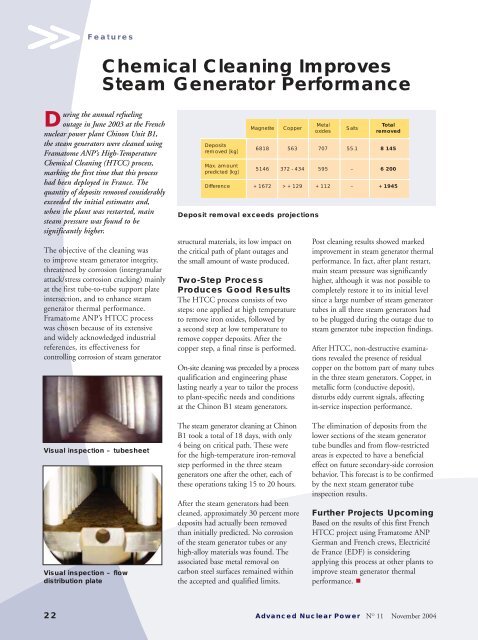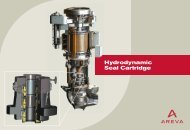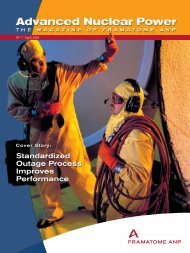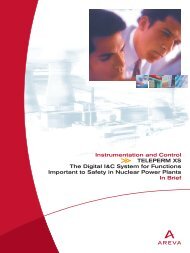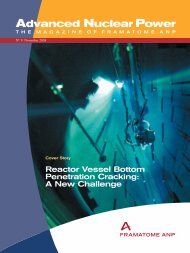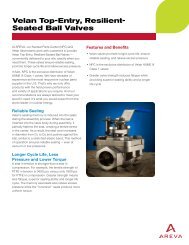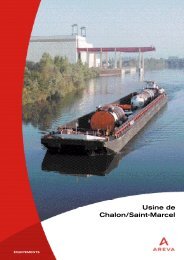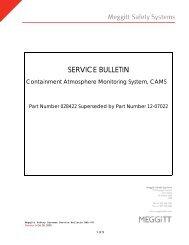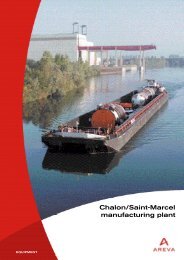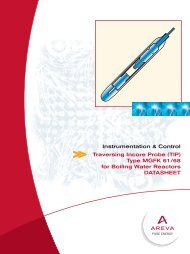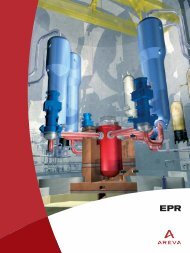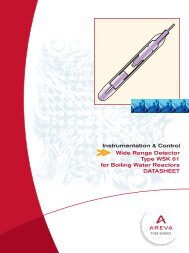You also want an ePaper? Increase the reach of your titles
YUMPU automatically turns print PDFs into web optimized ePapers that Google loves.
Features<br />
During the annual refueling<br />
outage in June 2003 at the French<br />
nuclear power plant Chinon Unit B1,<br />
the steam generators were cleaned using<br />
Framatome ANP’s High-Temperature<br />
Chemical Cleaning (HTCC) process,<br />
marking the first time that this process<br />
had been deployed in France. The<br />
quantity of deposits removed considerably<br />
exceeded the initial estimates and,<br />
when the plant was restarted, main<br />
steam pressure was found to be<br />
significantly higher.<br />
The objective of the cleaning was<br />
to improve steam generator integrity,<br />
threatened by corrosion (intergranular<br />
attack/stress corrosion cracking) mainly<br />
at the first tube-to-tube support plate<br />
intersection, and to enhance steam<br />
generator thermal performance.<br />
Framatome ANP’s HTCC process<br />
was chosen because of its extensive<br />
and widely acknowledged industrial<br />
references, its effectiveness for<br />
controlling corrosion of steam generator<br />
Visual inspection – tubesheet<br />
Visual inspection – flow<br />
distribution plate<br />
Chemical Cleaning Improves<br />
Steam Generator Performance<br />
Deposits<br />
removed [kg]<br />
Max. amount<br />
predicted [kg]<br />
Magnetite Copper<br />
Deposit removal exceeds projections<br />
structural materials, its low impact on<br />
the critical path of plant outages and<br />
the small amount of waste produced.<br />
Two-Step Process<br />
Produces Good Results<br />
The HTCC process consists of two<br />
steps: one applied at high temperature<br />
to remove iron oxides, followed by<br />
a second step at low temperature to<br />
remove copper deposits. After the<br />
copper step, a final rinse is performed.<br />
On-site cleaning was preceded by a process<br />
qualification and engineering phase<br />
lasting nearly a year to tailor the process<br />
to plant-specific needs and conditions<br />
at the Chinon B1 steam generators.<br />
The steam generator cleaning at Chinon<br />
B1 took a total of 18 days, with only<br />
4 being on critical path. These were<br />
for the high-temperature iron-removal<br />
step performed in the three steam<br />
generators one after the other, each of<br />
these operations taking 15 to 20 hours.<br />
After the steam generators had been<br />
cleaned, approximately 30 percent more<br />
deposits had actually been removed<br />
than initially predicted. No corrosion<br />
of the steam generator tubes or any<br />
high-alloy materials was found. The<br />
associated base metal removal on<br />
carbon steel surfaces remained within<br />
the accepted and qualified limits.<br />
Metal<br />
Total<br />
Salts<br />
oxides removed<br />
6818 563 707 55.1 8 145<br />
5146 372 - 434 595 – 6 200<br />
Difference + 1672 > + 129 + 112 – + 1945<br />
Post cleaning results showed marked<br />
improvement in steam generator thermal<br />
performance. In fact, after plant restart,<br />
main steam pressure was significantly<br />
higher, although it was not possible to<br />
completely restore it to its initial level<br />
since a large number of steam generator<br />
tubes in all three steam generators had<br />
to be plugged during the outage due to<br />
steam generator tube inspection findings.<br />
After HTCC, non-destructive examinations<br />
revealed the presence of residual<br />
copper on the bottom part of many tubes<br />
in the three steam generators. Copper, in<br />
metallic form (conductive deposit),<br />
disturbs eddy current signals, affecting<br />
in-service inspection performance.<br />
The elimination of deposits from the<br />
lower sections of the steam generator<br />
tube bundles and from flow-restricted<br />
areas is expected to have a beneficial<br />
effect on future secondary-side corrosion<br />
behavior. This forecast is to be confirmed<br />
by the next steam generator tube<br />
inspection results.<br />
Further Projects Upcoming<br />
Based on the results of this first French<br />
HTCC project using Framatome ANP<br />
German and French crews, Electricité<br />
de France (EDF) is considering<br />
applying this process at other plants to<br />
improve steam generator thermal<br />
performance.<br />
22 <strong>Advanced</strong> <strong>Nuclear</strong> <strong>Power</strong> N O 11 November 2004


